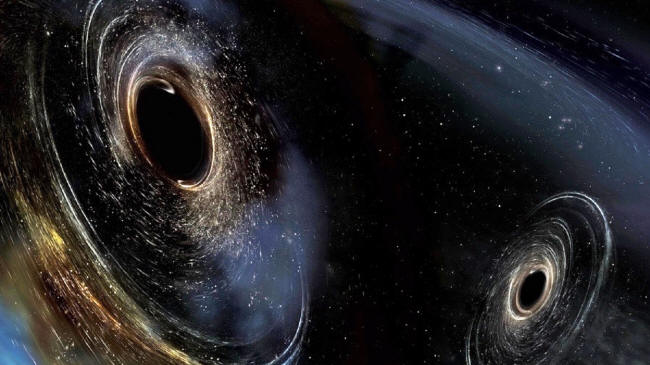|

by Katie Mack
July 06,
2019
from
CosmosMagazine Website
Spanish version

Artist's conception shows
two
merging black holes similar
to
those detected by LIGO in 2017.
LIGO/Caltech/MIT/Sonoma State
(Aurore
Simonnet)
Neutron star
collisions
appear to be
essential
to our chemical
origin story...
When,
in 2017, the LIGO experiment detected
gravitational waves from two neutron stars colliding, it sent
electromagnetic and gravitational ripples through the universe and
the astronomical community.
This remarkable event, hotly anticipated but never before seen in
this way, did more than give us a few new data points about the
deaths of stars - it fundamentally changed our understanding of
where we and our constituent atoms come from.
You may have heard before that "we are stardust".
This isn't wrong. But
it's not the whole story, either...
A star is, fundamentally, an alchemy machine. It
starts as a giant ball of mostly hydrogen gas, slowly crushing its
central regions with the pressure of its own gravity.
The core of a star
eventually gets so hot and dense that it becomes a nuclear
reactor, fusing hydrogen into helium.
In the core of
our own Sun, this process is
converting hundreds of millions of tons of hydrogen into helium
every second; what we receive as sunlight is essentially just the
waste heat from the reaction.
This is how the vast majority of stars spend their lives:
steadily burning
themselves up, turning hydrogen into helium for billions of
years.
In their final death
throes, as they become red giants ready to expel their outer layers,
the fusion flares up in bursts, making lithium, carbon and nitrogen,
and a smattering of heavier elements.
To fill in the rest of the periodic table, though, we need stars
much more massive than our own. A star more than about eight times
as massive as the sun contains at its centre a nuclear furnace
that's burning unimaginably hot.
After it tears through its supply of hydrogen in the core, it climbs
up the list of elements, burning,
helium, carbon, neon,
oxygen and silicon,
...until after only a few
million years the center of the star is iron and the fusion
radiation that had been puffing the star up finally runs out.
At that point, nothing can stop the star from collapsing on itself,
resulting in a spectacular
supernova explosion.
In the end, at the centre
of the debris field will be either a super-dense neutron star or a
black hole. It's this final explosion itself, rather than the
interior burning, that creates the star's ultimate chemical legacy.
For a brief moment, a
shock wave explodes through the layers of the star, creating heat
and pressure so intense that a blast front of nuclear fusion carries
a radioactive shell of new elements out into interstellar space.
The universe is seeded with stardust, ready to coalesce into new
stars, new planets, new life.
For years, it was thought
that these stellar deaths were the main mechanisms by which the
universe was enriched with metals and other heavy elements.
But evidence has been mounting that for heavy metals like gold,
platinum and uranium, the supernova is just the beginning. It's the
tiny, dense, neutron star that carries within it the potential to
explode across the rest of the periodic table.
Which brings us back to
the LIGO detection.
When the signal was first
seen, astronomers around the world trained their telescopes on the
same part of the sky. The resulting observations showed a clear sign
in the brief flash that the stars had created enough gold to
outweigh the Earth several times over.
Neutron star collisions appear to
be essential to our chemical origin story. We are born of
unimaginable violence in the stellar generations that came before
our own.
But there's more to the
story...
Most of the atoms in our bodies didn't come from stars at all. They
are, in fact, much more ancient. If you count up all the
atoms in your body, more than 60% will be hydrogen, and the majority
of the hydrogen in the universe has never been in a star at all.
Hydrogen, or, specifically, the protons that would later join
with electrons to make neutral hydrogen atoms, was created in
the primordial fire of
the Big Bang itself.
In the first moments of the universe, every part of space was filled
with a kind of prenuclear plasma hotter and denser than the
centre of even the most massive star.
As this fire expanded and cooled, protons and neutrons, the building
blocks of atomic nuclei, first came into being.
Hydrogen appeared in the form of solitary protons, along with small
amounts of helium and lithium. These nuclei have persisted for the
13.8 billion years since those first moments, coming together
in stars and, eventually, us.
"The atoms of
our bodies are traceable to stars
that
manufactured them in their cores
and exploded
these enriched ingredients across our galaxy,
billions of
years ago.
For this reason,
we are biologically connected
to every other
living thing in the world.
We are
chemically connected
to all molecules
on Earth.
And we are
atomically connected
to all atoms in
the universe.
We are not
figuratively,
but literally
stardust."
Source
So, yes, you are stardust...
But you are also the
ashes of the Big Bang:
ancient atomic
alchemy brought together by the inexorable flow of gravity and
time...
| 

